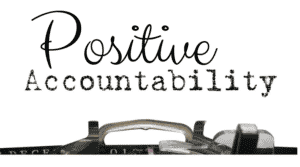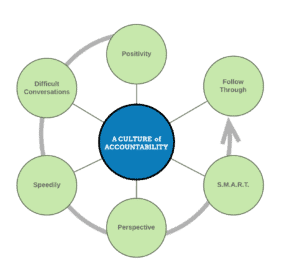As a business owner, when you hear the word ACCOUNTABILITY, what goes through your mind? Or, if you now consider yourself as an employee in your business, what would go through your mind when you hear the word ACCOUNTABILITY coming from the business owner or manager?
Is accountability about you having the self-discipline to be working on what really accounts, instead of just working reactively in your business? or as an employee, being summoned to the manager's office for your less than stellar performance?
For most people, the very name accountability has a negative association.
However, most will acknowledge that a level of accountability is necessary for overall performance. We all have our own insecurities, and we need to develop resilience and a level of persistence to improve and to NOT focus on what could go wrong. We need to acknowledge that it can be uncomfortable and difficult to be self-critical and to limit our blame on external forces, or others for some of our own actions or results. This is a big part of developing self-accountability.
Sadly, I have found very few business owners and managers demonstrate self-accountability, and I have been guilty of this too. If you are lacking in self-accountability, your ability to create self-accountability in others, and therefore the overall team as well, is doomed. When a business lacks accountability, we create an environment where employees are afraid to fail, tentative on their decision making, cautious about raising concerns and basically do not bring their A-game to work.
The following are the 6 critical steps to focus on in order to develop an accountability culture, starting from the top of the company, which is you.
1. Positive accountability
High performing business leaders promote a culture where accountability is celebrated. It’s where it plays a vital role in positively moving the team-- and the business as a whole-- FORWARD. Doesn’t it just make sense that if you've set individual and business goals with an expectation of full participation in achieving them, then everyone, from the top down, must be accountable for completing their specific tasks? 
The essence of accountability isn't all about punishing mistakes. It's about allowing your people to set goals, stretch goals in particular. By giving them the opportunity to find success with the support of the entire team and in a transparent way, while mistakes are highlighted and scrutinized for learning purposes. Being held accountable is a time to shine— a gift for your team members while contributing to a larger effort.
A culture of accountability is not good news for employees who consistently underperform. The environment we want to create is one of positivity, and of high expectations on performance. So, by default, the underperforming individuals need to be managed. If not, then the other team members who know they are failing in terms of performance will result in themselves feeling undervalued, discouraged or ignored, which may eventually lead them to quit. The magic word here is consistency. Everyone needs to be measured with the same yardstick that is relevant to their position, their ability and mitigating external factors.
As a business owner or leader, incorporating positive self-accountability as part of your daily practice is what differentiates effective leaders from the rest. Positive accountability when done right fosters a culture where team members help each other to perform better. It motivates everyone while building loyalty and trust.
2. Have that difficult conversation
Holding your team members accountable does not have to be continually confrontational. Always keep in mind to centre your attention to the process and outcomes, not the person. I recommend that it is a good practice to assume that most people are not being difficult on purpose, they really do want to do a stellar job.
When performance is below standard, begin your conversation with something specific: " (Employee), I noticed that (incident) happened. What do you think went wrong here?" And then wait for their reply.
All throughout your conversation, seek to really understand why certain actions were taken. Ask questions like: “Can you walk me through the process you used?’ or " Is there a technical issue we need to fix here?" or "Would it help you if I do the step by step with you the next time?" Focus your questioning on the process. Is there a flaw in the process? If so, how can we improve it?
Some members may not fully grasp how their behaviour affects the other members of the team. Address this point with them directly as productivity will be significantly improved if the team is acting cohesively. A good questioning approach on this point could be: “what impact do you think your actions had on the team?” and “what are the likely consequences on the team if this (incident) had to happen again?”
As a leader, it is your responsibility to ensure that you are fair and impartial. So before laying blame, consider the following:
- You, as their manager, didn’t give clear instructions.
- There’s a technical issue.
- The employee needs extra training.
- There are conflicting priorities.
- The employee has personal issues seeping into work.
3. Poor performance should be addressed as soon as possible
Nothing is likely to change unless you tackle the root cause of the problem, so it’s always better to deal with the person one-on-one, as soon as possible. After all, you don't want your employee's poor performance to become a bigger issue or your own frustrations to build up to a breaking point.
You need to figure out the reason behind the poor performance. This is a good time to find a way to make your leadership techniques match the situation. 
For instance, a tenured employee may have too much on their plate, while a new one just needs more training. A more laidback employee may do better with heavy authority while a highly conscientious team member may respond well to just a little coaching. Whatever the scenario is, you need to be clear about the behaviour or action you expect from your employee moving forward. Moreover, you should have recommendations on how to translate your expectations into reality. So, to what extent do you rely on your personal assessment of the individual? We are all subject to bias and recency in our thinking. If you have not performed a psychometric assessment on the individual, then now is the time. With more complete information on the individual, you are in a better situation to manage the employee. Read more about psychometric assessments here.
If you're faced with a truly difficult employee, do not rely on verbal communication alone. Collaborate on written instructions and goals with them that can aid you both to remain accountable. As their manager, you then will be forced to dig deeper to find ways to improve performance. This way the employee won't be able to make excuses of not knowing or not understanding the goals that were set.
4. Take your employee’s Perspective into consideration
Feelings are emotionally charged thoughts that have a powerful impact on how we act. As a leader, it's your job to be both aware and considerate of what is happening inside the head of the underperformer. What is their perspective of the situation? When you question them, they may be unable to give you a direct interpretation but rather a bunch of emotionally charged feelings, that are simply just related to the root cause. Your task is together with the person, to see deeper than the emotions and to identify the root cause. If you discover the root cause of the problem, do they agree with this finding? In order to progress, you ideally need to both agree on the root cause and their involvement and consequences in the situation. If you raise their defences and ignore their feelings, it becomes extremely difficult to progress beyond the potentially charged emotional state.
Let's take a look at this case on tardiness:
Employee A shows up, up to an hour late nearly every day. After a chat with her, you have learned that it's because she has to drop her children off at school before heading to work. She didn't have this issue with her last post since she started later than her new position requires.
Firstly, consider if it is vital that she starts work at the standard time. Could starting an hour later actually benefit the business? Secondly, if starting on time is crucial, then explain to her why it's crucial for everyone to start on time. Afterwards, seek to help her address the issue. She may need to find someone else to drop off her children in the morning or she may be able to find another daycare that has more suitable hours. Your aim here is to find a fair solution for all parties, although the priorities of the business need to come first.
5. Set S M A R T goals
When you are busy, it can be tempting to rush through some of the basics. S M A R T goal is a case in point. It is crucial to lay down your expectations for your people to perform well and to stay motivated.
In order to create a consistent flow of accountability in the team, you need to set SMART goals.
S M A R T stands for:
S – Specific
M –Measurable
A –Attainable
R –Relevant
T –Timely
There's a vast amount of information out there on developing SMART goals. It's a whole topic in itself and there's so much more to learn about it. However, to put it in perspective, SMART goals leaves very little to the imagination and it shows a clear line of communication between you and your employee. You can read more about SMART goals here.
6. Follow up and follow through
Writing minutes of each coaching session is a great way to keep track and stay on top of things. Of course, you don't need to make a full report of every issue, but you need to always take note of the issues that were addressed. This note should also include the solutions that were mutually agreed upon and expectations for future behaviour. By doing this, the clarity of the conversation is strengthened for all parties involved, and it gives you a paper trail to go back to should further action be necessary. 
From my personal experience, I have found that jotting down some summary bullet points after a 1-on-1 with a staff member has helped me significantly in focusing on the core issue and to have a formal record for effective follow-ups. You can also just do a quick chat with them. Perhaps the following morning to ask if they had any other ideas or questions after a night's rest. Then, do another follow up a week or so after just to know how things are going or ask them to follow up with you after a certain time.
By keeping yourself informed of their progress, you'll know if you need to make midstream adjustments to help them reach their goals. Make sure you're also holding up on your end of the bargain and praise them when things are done right! Nothing motivates great work like shining some light on the positive.
Lastly, ensure that everyone has at least one other person who is managing another in terms of accountability. If you own a small business with just a handful of employees, then it is likely that you will be this person. If however, the business is larger then encourage and coach more leaders to do what you are already doing.
Summary
Accountability is not about being a Sergeant Major. Accountability is about developing a high-performance team culture that is focused on the systems and process to deliver outcomes that are planned for. In high-performance organizations, these planned-for outcomes always have a stretch component in them, as this is what is required to excel in a competitive market place and to motivate staff. Developing a culture of self-accountability should be the aim of any organization. However, as much as you strive for this (and you really should be) the endpoint is the proverbial pot of gold at the end of the rainbow. You need to continually coach and lead people around self-accountability in order for this to happen. As a business leader, you need to continually improve the systems and processes in your business to enable and to encourage accountability. Lastly, you need to enlist an accountability partner for yourself in order to ensure that you are leading by example.


Recent Comments